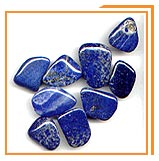
The "sapphire" of classical times, it has always been a popular stone on account of its fine blue colour. It is really a rock consisting of varying quantities of a blue mineral hauyne and calcite. Small specks and strings of the yellow iron pyrites are common.
The stone is becoming increasingly rare and its price rises steadily. It now costs more than gold and is the only opaque stone, apart from turquoise, sold by the carat (provided the quality is good). My personal advice is to choose a Saxe blue stone, of a bright compact texture, with no visible specks of white or green. To the contrary. golden threads in no way diminish the value of the stone and in fact are the means by which it may be identified. Lapis lazuli may be confused with sodalite, which has no golden threads, or blue aventurine, which has a schiller.
The stone is either cut as beads for necklaces or en cabochon for exclusive jewelry. It is especially attractive when set with diamonds or pearls.
The finest quality comes from Afghanistan, the lightest coloured from Chile, and other varieties from Russia and China. Widely popular in ancient times, the stone was sometimes used for decorating temples, but when the Romans realized that supplies were running low, they simply took to painting Carrara marble to resemble lapis lazuli.
![]()
| Name | Moh's | Specific Gravity | Structure | Cleavage | Refractive Index | Double | Disp. | Pleochro | Fluorescence |
| Lapis Lazuli | 6-May | 2.4-2.9 | Isometric | None | About 1.50 | None | None | None | Strong white |